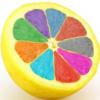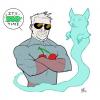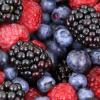Compiling and posting this merely as a reference for some of the less common dopaminergics. I decided to not include basic dopamine precursors like tyrosine, Mucuna etc. or basic stim's like caffeine and ephedrine simply because I figured most people were aware of how these substances effect the dopaminergic system.
Gotta start with a classic
St. John's wort (Hypericum perforatum) - A broad spectrum monoamine reuptake inhibitor with a high preference for noradrenaline and dopamine. Probably the most known dopaminergic supplement on the list and easily one of the more powerful ones.
[quote]Classic synthetic antidepressant drugs, as well as St John's wort extract (SJW), directly inhibit the re-uptake of norepinephrine (NE) and/or serotonin (5-HT) into pre-synaptic axons. With chronic treatment they induce adaptive changes in a number of neurotransmitter receptors in synaptic membranes. The immediate effects of SJW Ze 117, an extract low in hyperforin content, on the specific dopamine (DA) uptake were studied in rat striatal brain slices and compared with the effects on NE and 5-HT uptake in rat cortical brain slices. Specific DA uptake was inhibited in a dose dependent manner. In contrast to the findings in synaptosomal preparations published so far, the extract showed different inhibitory potencies for the respective transporters. The potencies for the uptake inhibition of NA, DA and 5-HT were 30, 7 and 1, respectively. The results indicate that the SJW Ze 117 extract interferes in three ways with the individual uptakes of the relevant neurotransmitters that are considered to be causal in the development of depression. This observation, the concomitant and potent inhibition of DA re-uptake by SJW extract, may additionally provide a rationale for the treatment of nicotine or drug addiction with SJW.[/quote]http://www.ncbi.nlm....pubmed/19585471
Babchi (Psoralea corylifolia) - The seeds work as a dual MAO inhibitor (preference for MAO-B) and dopamine and noradrenaline reuptake inhibitor. Potentially very powerful synergy between the MAO-B and DAT inhibition. Whole plant might be effective as well.
[quote]A petroleum ether extract (FP) from Fructus Psoraleae, seeds of Psoralea corylifolia L. (Leguminosae), was found to strongly inhibit dopamine (DA) uptake by dopamine transporter (DAT) heterogeneously expressed cells (D8 cells) and noradrenaline (NE) uptake by noradrenaline transporter (NET) heterogeneously expressed cells, which, however, had no effect on gamma-aminobutyric acid transporter heterogeneously expressed cells and serotonin transporter heterogeneously expressed cells at the concentration up to 100 microg/ml. These inhibitory effects were also confirmed by experiments on SK-N-SH cell line and synaptosomes from rats' brains. In addition, FP showed a significantly mitigating effect on 1-methyl-4-pyridinium induced injury of D8 cells. Meanwhile, FP dose-dependently reduced the binding of tritium-labeled cocaine analog (-)-2beta-carbomethoxy-3beta-(4-fluorophenyl) tropane to DAT of D8 cells, which suggests that FP may inhibit DAT activity in the same way as cocaine does. Behavioral study showed FP had a long-lasting stimulant effects on the activity of intact mice and reserpinized mice. So FP is proposed as a kind of DAT and NET inhibitor and may be involved in the process of regulating the DA and NE system, and FP or its unknown bioactive compounds may be developed into new medicines for disorders such as Parkinson's disease, depression, Attention Deficit Hyperactivity Disorder (ADHD) or cocaine addiction.[/quote]http://www.ncbi.nlm....pubmed/17555897
Catuaba - A bark extract derived from several varieties of tree and often sold under the fake scientific name of Erythroxylum catuaba. Acts as a dopamine reuptake inhibitor as well as promotes the release of dopamine. Has been shown to prevent rotenone-induced apoptosis to dopamine neurons. Inhibits the reuptake of dopamine more selectively than St John's wort.
[quote]RESULTS: Acute oral treatment with the extract of T. catigua produced antidepressant-like effects in the forced swimming model in both mice and rats. Anti-immobility actions of T. catigua extract in mice were significantly reversed by haloperidol or by chlorpromazine, but not by pimozide, ketanserin, spiroxatrine or p-chlorophenylalanine. In vitro, T. catigua extract concentration-dependently inhibited the uptake and increased the release of serotonin, and especially of dopamine, from rat brain synaptosomal preparations.
CONCLUSIONS: The present study provides convincing evidence for a dopamine-mediated antidepressant-like effect of the active principle(s) present in the hydroalcoholic extract of T. catigua in mice and rats when in vivo and in vitro strategies were employed. Therefore, a standardized T. catigua extract or its purified constituents could be of potential interest for the treatment of depressive disorders.[/quote]http://www.ncbi.nlm....pubmed/15991001
Chinese Skullcap (Scutellaria baicalensis) - Another dopamine reuptake inhibitor. Has also been shown to prevent iron-induced neurodegredation of the dopaminergic system.
[quote]In previous studies we have demonstrated that the γ-aminobutryic acid-A (GABA-A) receptor antagonist oroxylin A has an awakening effect and it also represses ADHD-like behaviors (hyperactivity, impulsivity and inattention) in the spontaneously hypertensive rat (SHR) model of attention-deficit hyperactivity disorder (ADHD). We hypothesized that the effects of oroxylin A were exerted via the GABA-A receptor given the important role of the GABAergic system in ADHD. However, it is possible that aside from the GABAergic system, oroxylin A may influence other systems especially those implicated in ADHD (e.g. DAergic, etc.). To test this hypothesis, we evaluated the effects of GABA agonist, or dopamine (DA) antagonist in oroxylin A-induced alleviation of ADHD-like behaviors in SHR. SHR showed inattention and impulsivity as measured by the Y-maze and the electro-foot shock aversive water drinking tests, respectively. Oroxylin A significantly improved these behaviors, furthermore, its effect on SHR impulsivity was attenuated by haloperidol, a DA antagonist, but not by baicalein, an agonist of the GABA-A receptor. In vitro studies showed that oroxylin A inhibited DA uptake similar to methylphenidate, a dopamine transporter blocker, but did not influence norepinephrine uptake unlike atomoxetine, a selective NE reuptake inhibitor. Collectively, the present findings suggest that oroxylin A improves ADHD-like behaviors in SHR via enhancement of DA neurotransmission and not modulation of GABA pathway as previously reported. Importantly, the present study indicates the potential therapeutic value of oroxylin A in the treatment of ADHD.[/quote]http://www.ncbi.nlm....pubmed/23371806
Magnolia extract (Magnolia officinalis) - Acts as a dopamine reuptake inhibitor as well as a D5 antagonist, has shown to prevent 6-OHDA-induced lesions to the dopaminergic system.
[quote]RESULTS: Interactions were demonstrated with the adenosine A(1) receptor, dopamine transporter and dopamine D(5) receptor (antagonist activity), serotonin receptors (5-HT(1B) and 5-HT(6) antagonist activity) and the GABA benzodiazepine receptor at a concentration of 100 microg/ml or lower. ME had an affinity with adenosine A(1) (K(i) of 9.2+/-1.1 microg/ml) and potentiated the GABA activated chloride current at the benzodiazepine subunits of the GABA receptor (maximum effect at 50 microg/ml). ME had a modest antagonist action with 5-HT(6) and ZE with the 5-HT(1B) receptor.[/quote]http://www.ncbi.nlm....pubmed/19505549
Jiaogulan (Gynostemma pentaphyllum) Has a restorative effect on dopaminergic systems after chronic stress and 6-OHDA-induced neurotoxicity. Unique in its proven abilities to promote healing of the dopaminergic system, rather than just prevent degredation.
[quote]6-Hydroxydopamine administration for 28 days (8 microg/2 microL) reduced the number of tyrosine hydroxylase (TH)-immunopositive neurons to 40.2% in the substantia nigra compared to the intact contralateral side. Dopamine, 3,4-dihydroxyphenylacetic acid, homovanillic acid and norepinephrine levels were reduced to 19.1%, 52.3%, 47.1% and 67.4% in the striatum of 6-hydroxydopamine-lesioned rats compared to the control group, respectively. However, an oral administration of herbal ethanol extracts from Gynostemma pentaphyllum (GP-EX) (10 mg/kg and 30 mg/kg) starting on day 3 post-lesion for 28 days markedly ameliorated the reduction of TH-immunopositive neurons induced by 6-hydroxydopamine-lesioned rat brain from 40.2% to 67.4% and 75.8% in the substantia nigra. GP-EX administration (10 and 30 mg/kg) also recovered the levels of dopamine, 3,4-dihydroxyphenylacetic acid, homovanillic acid and norepinephrine in post-lesion striatum to 64.1% and 65.0%, 77.9% and 89.7%, 82.6% and 90.2%, and 88.1% and 89.2% of the control group. GP-EX at the given doses did not produce any sign of toxicity such as weight loss, diarrhea and vomiting in rats during the 28 day treatment period and four gypenoside derivatives, gynosaponin TN-1, gynosaponin TN-2, gypenoside XLV and gypenoside LXXIV were identified from GP-EX. These results suggest that GP-EX might be helpful in the prevention of Parkinson's disease. [/quote]http://www.ncbi.nlm....pubmed/20428081
Bacopa (Bacopa monnieri) - Seems to regulate dopaminergic system pretty effectively, maintaining the amounts of neurotransmitters and receptors when they'd normally drop (e.g. during chronic stress, 6-OHDA and rotenone-induced neurotoxicity), and preventing dopamine surges in the striatum, possibly mitigating drug-related reward systems and level of addiction.
[quote]Neonatal hypoglycaemia initiates a series of events leading to neuronal death, even if glucose and glycogen stores return to normal. Disturbances in the cortical dopaminergic function affect memory and cognition. We recommend Bacopa monnieri extract or Bacoside A to treat neonatal hypoglycaemia. We investigated the alterations in dopaminergic functions by studying the Dopamine D1 and D2 receptor subtypes. Receptor-binding studies revealed a significant decrease (p < 0.001) in dopamine D1 receptor number in the hypoglycaemic condition, suggesting cognitive dysfunction. cAMP content was significantly (p < 0.001) downregulated in hypoglycaemic neonatal rats indicating the reduction in cell signalling of the dopamine D1 receptors. It is attributed to the deficits in spatial learning and memory. Hypoglycaemic neonatal rats treated with Bacopa extract alone and Bacoside A ameliorated the dopaminergic and cAMP imbalance as effectively as the glucose therapy. The upregulated Bax expression in the present study indicates the high cell death in hypoglycaemic neonatal rats. Enzyme assay of SOD confirmed cortical cell death due to free radical accumulation. The gene expression of SOD in the cortex was significantly downregulated (p < 0.001). Bacopa treatment showed a significant reversal in the altered gene expression parameters (p < 0.001) of Bax and SOD. Our results suggest that in the rat experimental model of neonatal hypoglycaemia, Bacopa extract improved alterations in D1, D2 receptor expression, cAMP signalling and cell death resulting from oxidative stress. This is an important area of study given the significant motor and cognitive impairment that may arise from neonatal hypoglycaemia if proper treatment is not implemented.[/quote] http://www.ncbi.nlm....pubmed/23975094
N-acetyl-cysteine - Also regulates the dopaminergic system in a similar way to bacopa, although seemingly less effectively.
[quote]The amphetamine (AMPH)-induced alteration in rat brain dopamine levels modified by N-acetylcysteine (NAC) administration has been examined using isocratic ion-pair reversed-phase high-performance liquid chromatography with electrochemical detection. The aim of the development of a novel validated evaluation scheme implying a double AMPH challenge was to enhance the efficiency of AMPH-triggered dopamine release measurements in rat brain striatal slices by improving the reproducibility of the results. The proposed experimental protocol was tested in vivo and proved to be capable of fast and reliable drug screening for tracing the effect of NAC as a model compound in AMPH-mediated dopaminergic response. The subcellular localization of the dopamine mobilizing effect of NAC has been established indirectly by the use of an irreversible dopamine vesicular depletor, reserpine. The antioxidant NAC at 10 mM plays an important role in the complete suppression of acute AMPH-elicited dopamine release. The possible role of this quenching effect is discussed.
[/quote]http://www.ncbi.nlm....pubmed/19277967
Alpha GPC - Increases dopamine transporters, potassium stimulated dopamine release, as well as DOPAC levels in the frontal cortex and the cerebellum.
[quote]Choline-containing phospholipids were proposed as cognition enhancing agents, but evidence on their activity is controversial. CDP-choline (cytidine-5´-diphosphocholine, CDP) and choline alphoscerate (L-alpha-glycerylphosphorylcholine, GPC) represent the choline-containing phospholipids with larger clinical evidence in the treatment of sequelae of cerebrovascular accidents and of cognitive disorders. These compounds which display mainly a cholinergic profile interfere with phospholipids biosynthesis, brain metabolism and neurotransmitter systems. Dated preclinical studies and clinical evidence suggested that CDP-choline may have also a monoaminergic profile. The present study was designed to assess the influence of treatment for 7 days with choline-equivalent doses (CDP-choline: 325 mg/Kg/day; GPC: 150 mg/Kg/day) of these compounds on brain dopamine (DA), and serotonin (5-HT) levels and on DA plasma membrane transporter (DAT), vesicular monoamine transporters (VMAT1 and VMAT2), serotonin transporter (SERT), and norepinephrine transporter (NET) in the rat. Frontal cortex, striatum and cerebellum were investigated by HPLC with electrochemical detection, immunohistochemistry, Western blot analysis and ELISA techniques. CDP-choline did not affect DA levels, which increased after GPC administration in frontal cortex and cerebellum. GPC increased also 5-HT levels in frontal cortex and striatum. DAT was stimulated in frontal cortex and cerebellum by both CDP and GPC, whereas VMAT2, SERT, NET were unaffected. VMAT1 was not detectable. The above data indicate that CDP-choline and GPC possess a monoaminergic profile and interfere to some extent with brain monoamine transporters. This activity on a relevant drug target, good tolerability and safety of CDP-choline and GPC suggests that these compounds may merit further investigations in appropriate clinical settings.[/quote]http://www.ncbi.nlm....pubmed/23244432
CDP Choline - Increases dopamine transporters as well as prevents the decline in dopamine receptor density that comes with aging, increases striatal dopamine levels and potentially acts as a unique dopamine antagonist with potential applications in Parkinson's.
[quote] Spiroperidol binding (dopamine D2 receptors) and quinuclidinyl benzilate binding (muscarinic receptors) in striata of 19-month old mice was analyzed for animals that had received chronic administration of cytidine 5'-diphosphocholine (CDP-choline) incorporated into the chow consumed (100 or 500 mg kg-1 added per day) for the 7 months before they were killed. 2. Treated animals displayed an increase in the dopamine receptor densities of 11% for those receiving 100 mg kg-1 and 18% for those receiving 500 mg kg-1 as compared to the control aged animals that had received no CDP-choline. Control animals showed, from 2 months to 19 months of life, a 28% decrease in the receptor density. No change in the affinity of the receptors for spiroperidol was found in the treated or untreated animals. 3. Muscarinic acetylcholine receptor densities were also partially recovered by the same treatment in aged animals that showed a 14% decrease of these receptors in this case. The muscarinic receptor density increased 6% for the animals that received 100 mg kg-1 and 17% for the animals that received 500 mg kg-1 without any change in the affinity of the receptor for quinuclidinyl benzilate. 4. Aged animals displayed a slight increase in brain membrane fluidity as indicated by a decrease in the polarization value of the non-polar fluorophore 1,6-diphenyl-1,3,5-hexatriene. Interestingly, in the treated animals a greater increase in membrane fluidity was determined and found to be very similar for the two doses.5. It is concluded that chronic administration of CDP-choline to aged animals promoted a partial recovery of the striatum dopamine and acetylcholine receptor function normally reduced with aging, which might be explicable in terms of mechanisms involving fluidity of the brain neuronal membrane.[/quote]http://www.ncbi.nlm..../pubmed/7253343
Ginkgo (Ginkgo biloba) - A MAO-B inhibitor that seems to preferentially increase dopamine and noradrenaline over other monoamines.
[quote]KEY RESULTS: A single oral dose of EGb 761 (100 mg.kg(-1)) had no effect on monoamine levels. However, following chronic (100 mg.kg(-1)/14 days/once daily) treatment, the same dose significantly increased extracellular dopamine and noradrenaline levels, while 5-HT levels were unaffected. Chronic treatment with EGb 761 showed dose-dependent increases in frontocortical dopamine levels and, to a lesser extent, in the striatum. The extracellular levels of HVA and DOPAC were not affected by either acute or repeated doses. Treatment with the main constituents of EGb 761 revealed that the increase in dopamine levels was mostly caused by the flavonol glycosides and ginkgolide fractions, whereas bilobalide treatment was without effect.
CONCLUSIONS AND IMPLICATIONS: The present results demonstrate that chronic but not acute treatment with EGb 761 increased dopaminergic transmission in the PFC. This finding may be one of the mechanisms underlying the reported effects of G. biloba in improving cognitive function.
[/quote]http://www.ncbi.nlm....pubmed/20105177
Jatamansi (Nardostachys jatamansi) - Another MAO-B inhibitor that seems to preferentially increase 5HT and GABA more so than dopamine and adrenaline. Also prevents 6-OHDA induced neurodegeneration of dopaminergic systems.
[quote]The effect of acute and subchronic administration of an alcoholic extract of the roots of Nardostachys jatamansi on norepinephrine (NE), dopamine (DA), serotonin (5-HT), 5-hydroxyindoleacetic acid (5-HIAA), gamma-aminobutyric acid (GABA), and taurine were studied in male albino Wistar rats. The acute oral administration of the extract did not change the level of NE and DA but resulted in a significant increase in the level of 5-HT and 5-HIAA. A significant increase in the level of GABA and taurine was observed in the drug-treated groups when compared to the controls. A 15-day treatment resulted in a significant increase in the levels of NE, DA, 5-HT, 5-HIAA, and GABA. These data indicate that the alcoholic extract of the roots of N. jatamansi causes an overall increase in the levels of central monoamines and inhibitory amino acids.
[/quote]
Clary Sage Oil (Salvia sclarea) - A close cousin of clary sage, Salvia palaestina, shows promise as well since it has constituents that have high binding affinity with dopamine receptors at fairly low levels, however its greatly understudied.
[quote]RESULTS: Among the essential oils tested, 5% (v/v) clary oil had the strongest anti-stressor effect in the FST. We further investigated the mechanism of clary oil antidepression by pretreatment with agonists or antagonists to serotonin (5-HT), dopamine (DA), adrenaline, and GABA receptors. The anti-stressor effect of clary oil was significantly blocked by pretreatment with buspirone (a 5-HT(1A) agonist), SCH-23390 (a D(1) receptor antagonist) and haloperidol (a D(2), D(3), and D(4) receptor antagonist).
CONCLUSIONS: Our findings indicate that clary oil could be developed as a therapeutic agent for patients with depression and that the antidepressant-like effect of clary oil is closely associated with modulation of the DAnergic pathway.[/quote] http://www.ncbi.nlm....pubmed/20441789
Beta-alenine - Seems to increase dopamine release in the Nucleus accumbens through agonising the glycine receptor in a similar, albeit weaker, manner to alcohol.
[quote]Glycine receptors (GlyRs) in the nucleus accumbens (nAc) have recently been suggested to be involved in the reinforcing and dopamine-elevating properties of ethanol via a neuronal circuitry involving the VTA. Apart from ethanol, both glycine and taurine have the ability to modulate dopamine output via GlyRs in the same brain region. In the present study, we wanted to explore whether yet another endogenous ligand for the GlyR, beta-alanine, had similar effects. To this end, we monitored dopamine in the nAc by means of in vivo microdialysis and found that local perfusion of beta-alanine increased dopamine output. In line with previous observations investigating ethanol, glycine and taurine, the competitive GlyR antagonist strychnine completely blocked the dopamine elevation. The present results suggest that beta-alanine has the ability to modulate dopamine levels in the nAc via strychnine-sensitive GlyRs, and are consistent with previous studies suggesting the importance of this receptor for modulating dopamine output.[/quote]http://www.ncbi.nlm....pubmed/19543795
Patchouli (Valeriana wallichii) - The alcohol extract increases dopamine levels in mouse forebrain, while the water extract decreases dopamine levels in mouse frontal cortex. Has compounds that have neuroprotective effects against neuronal cell death in "human dopaminergic neuroblastoma SH-SY5Y cells".
[quote] MATERIALS AND METHODS: Antidepressant effect of dichloromethane extract of Valeriana wallichii (10, 20 and 40mg/kg, p.o.) using forced swim test, was determined in both acute and chronic study. The neurotransmitter levels were estimated in mouse forebrain after two weeks of dosing.
RESULTS: Single administration of extract (40mg/kg) significantly inhibited the immobility period in mice (p<0.05). Similarly, chronic administration of extract (20 and 40mg/kg) significantly reduced the immobility period and significantly increased the levels of norepinephrine and dopamine in mouse forebrain (p<0.05).
CONCLUSIONS: The extract demonstrated antidepressant effect and significantly increased the norepinephrine and dopamine levels in forebrain.[/quote]http://www.ncbi.nlm....pubmed/21354297
Chaste Berry (Vitex agnus castus) - Acts as a dopamine mimetic for certain systems. Several supplements primarily used for treating symptoms of menopause and PMS act primarily though the dopaminergic systems.
[quote]Women suffering from premenstrual mastodynia often respond to stimuli of prolactin (Prl) release with a hypersecretion of this hormone. Pharmacological reduction of Prl release by dopamine agonists or treatment with extracts of Agnus castus (AC) improve the clinical situation of patients with such premenstrual symptoms. Extracts of AC contain compounds which inhibit in vivo Prl release in women as well as in vitro from dispersed rat pituitary cells. It is yet unknown whether this inhibitory action of AC is only exerted on Prl release or whether release of other pituitary hormones like LH and FSH is also affected. The effects of AC on LH and FSH release were examined in vitro using rat pituitary cell cultures. To rule out that the Prl-inhibiting properties of AC are at least in part due to a cytotoxic component, pituitary cell cultures were subjected to the MTT test. To assess whether the Prl inhibitory effect of AC preparations is due to compounds acting as dopamine (DA) agonists, we used the corpus striatum membrane DA receptor binding assay. Our results demonstrate for the first time that AC extract contains an active principle that binds to the D2 receptor. Thus, it is very likely that it is this dopaminergic principle which inhibits Prl release in vitro from rat pituitary cells. Furthermore we give evidence for the specificity of action of AC on hormone release, since gonadotropin secretion remained unaffected. The findings of the present study support the therapeutical usefulness of AC extracts for treatment of premenstrual mastodynia which is associated with hypersecretion of Prl. Furthermore, the beneficial effects of AC appear to be due to the inhibition of pituitary Prl release.[/quote] http://www.ncbi.nlm..../pubmed/7890021
Black Kohosh (Cimicifuga racemosa) - Another supplement used primarily for PMS and menopause, seems to act in a similar manner to chaste berry on the D2 receptors.
[quote]RESULTS: While a displacement of radiolabeled estradiol from binding sites of a cytosol preparation from procine and human endometrium by CR extract BNO 1055 was shown no such displacement was achieved when either ERalpha or ERbeta protein was used as ligands for tracer. Dopaminergic activity in the CR extract BNO 1055 could be demonstrated with the D(2)-receptor assay. A countercurrent chromatography resulted in a separation of estrogenic and dopaminergic activity in two distinct fractions.
CONCLUSIONS: It is suggested that not yet identified substances in the CR extract BNO 1055 bind to a yet unknown estrogen-binding site in the endometrium. Also, yet unknown dopaminergic compounds may contribute to the pharmacological profile of CR extract BNO 1055.
[/quote]http://www.ncbi.nlm....pubmed/12609557
Edited by Bateau, 17 December 2013 - 07:41 PM.

























































